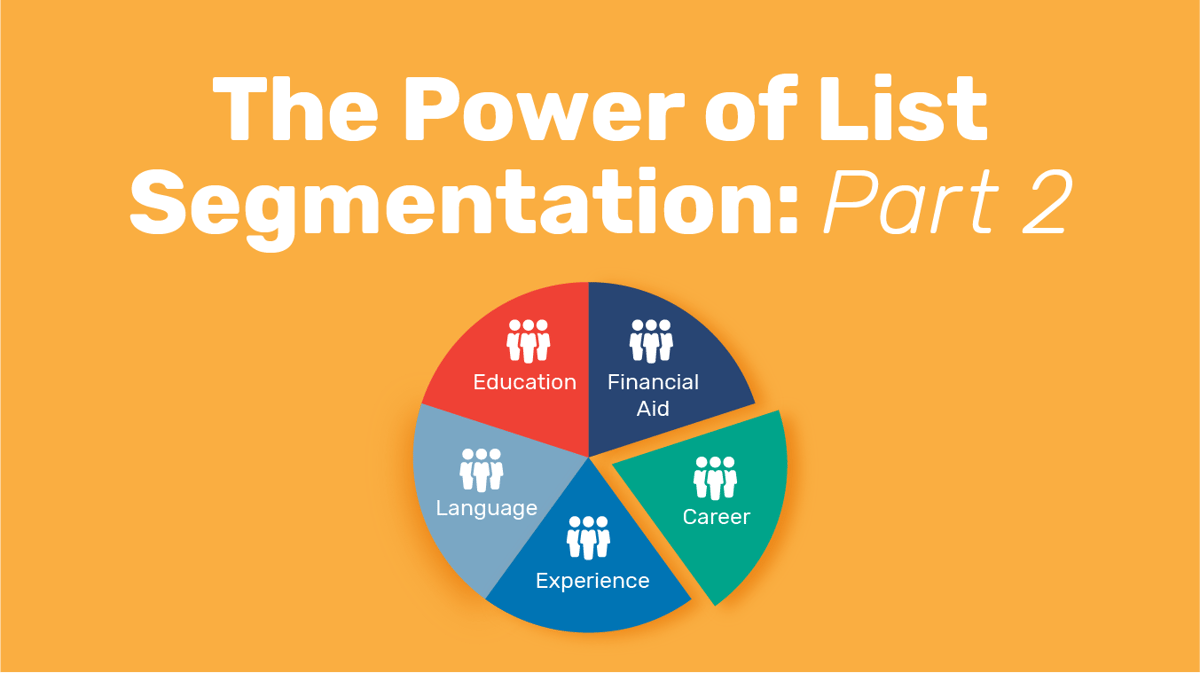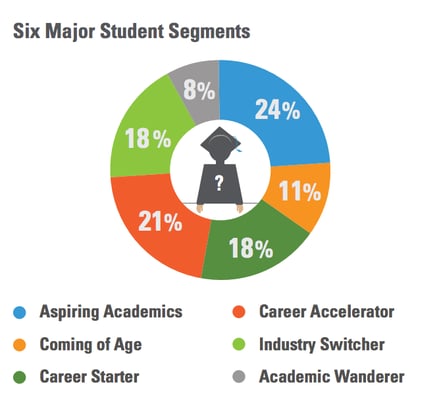
Last week’s blog post kicked off our mini-series on audience segmentation with a discussion on segmentation by demographics, geography and interests. This week we will delve into models for identifying underlying student motivations and how to make use of this data for your international student recruiting.
Psychographic segmentation identifies unique groups of students with shared motivations and desires in order to help you, as a recruiter, discover what drives them to enroll at your institution. Student's don't just show up on your doorstep. They must be motivated to seek out your institution, out of all your competition.
Here's an interesting audience segment: 50% of Nafsan's think that Artificial Intelligence (AI) will change Higher Education but they don't know how. We aim to fix that! Intead Plus Members will have access to an exclusive webinar about AI and Higher Ed on Thursday, March 28, 2019 at 1 pm. Not an Intead Plus Member and still want in? We might know some people at the door! Drop us an email.
The market segments we discuss below are common to most student groups no matter their geographic origins. Yet, each segment will respond more or less to different influencers, based on what part of the globe they come from.
There are so many ways to parse the data. No wonder so few institutions take the time to implement this granular approach to marketing. You know other industries, including clothing retailers, are doing this stuff with their digital marketing. it's not that hard to do. But it takes time.
Retailers use CRM platforms and employ small teams of people to write copy and develop marketing approaches for each clothing line based on audience segmentation. They commit the resources to meet each audience segment with the right information, at the right time, to help them make an informed decision about a purchase. Although the service your institution provides differs wildly from the offerings of any retailer, the granular level of segmentation is relevant and applicable to your specific academic programs and the audience segments you are approaching for each one.
Bottom Line: We certainly see parallels with how retailers and universities can communicate their offerings to audience segments and cross sell (students interested in this program also pursued interests in these areas...). What we don’t see is a parallel commitment of resources. Academics are so often strained by budgets and limited resources, but the reality is that those committed to growth and success commit funds to reaching the right audience with the right information.
Your prospects are highly motivated to achieve, find, and experience something. It is your job to identify what it is that they are seeking so that you can help them make a good decision. You want to help them recognize that your institution is the right choice for their unique needs. Help them make the match between their interests and goals your academic strengths.
Discovering what motivates your prospects allows you to attract the kind of successful students that you want on your campus by creating an effective line of communication. You can discuss what they need to hear, rather than all the things you think they want to hear. Collecting the right data helps you streamline your communication process.
Today, they identify themselves by their clicks, as long as you are listening.
Segmentation Way Back... Before You www'd?
Segmenting for university recruitment goes way back and research proves its relevance. Research published in 1989, by the Association for Consumer Research surveyed potential students of Texas Christian University (TCU) to separate them into segments. This research identified what was most important to each segment when choosing a university.
The first segment focused on everything except social activities, the second segment focused almost exclusively on academics, the third focused on a combination of social aspects of the university and academics, segment four focused on the university’s religious affiliation and segment five rated financial considerations as the most important. The research showed that the percentage of students from each group that enrolled at TCU was pretty evenly split across the total student population.
This study explains that the balanced enrollment at the university was likely because they had focused similar marketing attention on each segment -- that their marketing by segment produced enrollment results for each segment. Perhaps not surprising, but it documents the point.
Despite this study occurring before email marketing and Instagram were twinkles in someone’s eye, the principle remains the same: identifying your key audiences, and marketing specifically to them, can attract the right kind of students and improve enrollment on your campus. Much more recent research can help us focus our message and how we disseminate it in today’s fast-pace and technology-filled, clickable and trackable environment.
Segmentation Research
The Parthenon Group, as we mentioned in a previous post, has a valuable view of segmentation for domestic recruiting. If you’ve not read this one, we highly recommend it. Great insights from this well-researched article.
 Source: The Parthenon Group
Source: The Parthenon Group
Each of these six segments above has different motivations for returning to school. Each segment may find their information through different channels. Additionally, each segment needs different information to make a decision about where to study. That is incredibly helpful to know, since, as a recruiter, you need to tap into what is really prompting a student to jump through the necessary hoops to make it from another part of the globe to your campus.
WES also provides a helpful model for identifying psychographic student segments among international students. (Yes, it is the one you've seen before, but still helpful). This approach divides them into four categories:
- Explorers: Students who have financial resources and low academic preparedness
- Highfliers: Students who have high financial resources and high academic preparedness
- Strivers: Students who have low financial resources and high academic preparedness
- Strugglers: Students who have low financial resources and low academic preparedness

Another report (registration required) by WES stated the importance of mapping the behavior of international students by proclaiming what should be your mantra, “not all international students are the same.”
In general, all segments cited expansion opportunities for career and life as aspects for pursuing an education abroad. However, the Highfliers and Strivers were more motivated by the quality of education and its influence on career opportunities. Strivers, true to their name, can be described as the group that is most after the American dream. Highfliers, less concerned about the American dream, and more influenced by the prestige of the prospective university. The Strugglers and Explorers are motivated by the idea of living in a foreign country and improving their English. Even so, strugglers are more interested in the financial aid options that universities have to offer.
Want insights into the motivations of students from different geographic backgrounds? Our latest Know Your Neighborhood report received responses from 57,471 students from 65 countries around the world. Check it out.
Segmentation & Digital Marketing
Motivation is the recognition that there is a difference between our reality and our dreams or aspirations – it is that feeling that "something" is missing. When communicating with students, this is your opportunity to show them that you can help them achieve their goals. You do this by revealing your key differentiators.
Segmenting your email workflows and digital ads will help you decide when to talk about academic excellence at your university or when to tell prospects about what innovations your graduates have gone on to discover and what jobs they now hold. It is the difference between knowing when to tell a student about the best financial aid package the university offers international students and when to talk about the experiences that international students may have on campus (graduate assistantship opportunities anyone?). It is email content and clickable ads tailor-made to match with each student segment's desires.
Stay tuned for Part III of this series next week to learn about which communication channels are best to reach your prospective international students and which messengers are most engaging at which points in the recruitment funnel. Yes, we will be talking about lead scoring!

